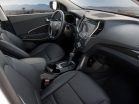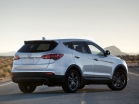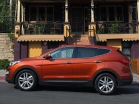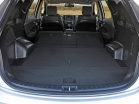Hyundai Santa Fe Test drive since 2012 SUV
The test drive of the new Hyundai Santa Fe: Well, Santa!
I look at the new Santa Fe illuminated by the rare December sun and I can’t tear myself away. How strong, assertive it turned out. How bizarrely lies long winter shadows on a relief hood and hind wings. And the lines are no longer flowing according to the laws of the corporate style, but are rapidly rushing throughout the body and disappear somewhere on the roll of the rear door. Effective. Modernly. The new Santa Fe is a real design success.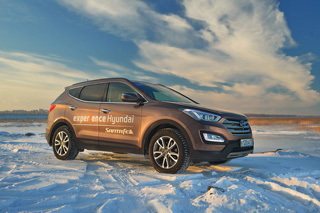
At the same time, the third -generation crossover is the complete opposite of their calm discreet predecessors. Do not carry a branded nameplate with a warm name of the southern American town and a piece of the sun in his stern, you will never guess that this lean frant is a direct heir to that chubby simpleton, which appeared at the beginning of the century, and his inexpressive descendant. What are they there, because even a large IX55, standing next to the Motor Show, is lost against his background.
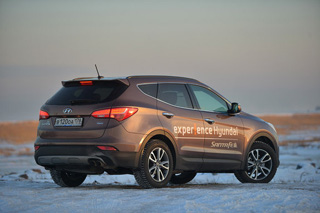
By the way, with a change in generations, two of its main geometric dimensions Santa Fe remained true to almost a millimeter, but the height of the crossover decreased by as much as twelve centimeters at once. Moreover, this did not affect the sensations of passengers: from the crown to the ceiling here, as before, there is a good air supply. In general, an enviable spaciousness in the back seat, its successful profile and a wide range of adjustment of the angle of inclination of the backs, Hyundai is very reminiscent of Kia Sorento, which we recently met.
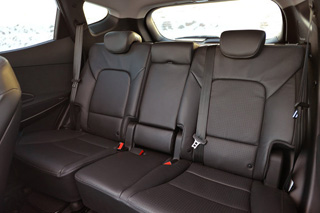
The possibilities of adjusting the rear seats in Santa Fe are not inferior to another driver. But besides, they also have two -stage heating.
The only difference between them is that the Santa Fe sofa, divided in a proportion of 60:40, also has a useful longitudinal adjustment, which allows you to move the seats back and forth to good thirteen centimeters. It is only a pity that, such a spectacular on the outside, running up the glazing line, ultimately worsens the overview of both the driver himself and the rear passengers through their small side windows. Although, at the same time, this architecture with a predominance of metal over glass gives an equally important sense of safety and security. Maybe just for this reason, or maybe simply because of a lack of light and a dark leather salon, but whenever I sat back, I noticed that I would start to peck my nose.
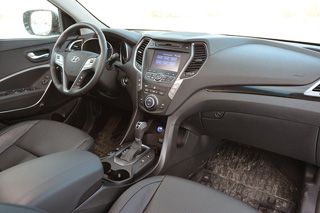
Stylistically sustained with the appearance of the crossover, the central console is neat and functional. And thanks to the color touch screen, there are fewer buttons on it. By the way, the display has a night mode that completely disconnects its backlight.
The interior of Santa Fe in style is very similar to the appearance: the same expression, the same neighborhood of straight and broken lines, trapezes and sharp corners. And this variety of forms is not annoying. On the contrary, along with a small number of buttons and the absence of cheap in the appearance of gray plastic, the central console is concise and looks good. It is only more elegant by devices with funny, lying in another plane, round screen indicators of the temperature of the coolant and fuel supply.


There are enough places for small everyday things in Hyundai: pockets in the doors, formed for a bottle, a capacious box in a armrest, deep and airy, like an I30 hatchback, a niche in the bowels of a central console. By the way, with a rubberized coating, it will fit as a haven for a mobile phone, but the glove compartment, although she came out as roomy, but did not get upholstery.

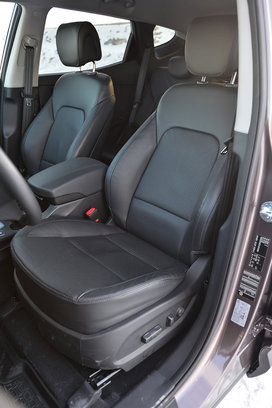
The soft driver's seat is convenient and, in addition to three -stage heating, it is equipped with almost all possible electroregies. And large people and large people will be happy with widely placed rollers. One trouble: in order to close the wide open door and reach the inner handle-carm, you need to show miracles of flexibility, falling out of the car with the whole body.
It’s not pleasant pleasure in a cold machine, but the cabin of the Korean crossover warms up quite quickly. What can not be said about the steering wheel sheathed with soft skin. He just acquires a pleasant temperature to his hands reluctantly. Eh, he would be heated, how is one a concern on Sorento, why was it deprived? But the steering wheel is endowed with variable, but frankly with an artificial effort, the value of which can be chosen by the button on the right knitting needle, and also well isolated from road irregularities. And they are not in the salon, no, but they appear.
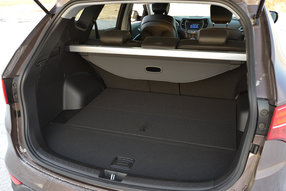
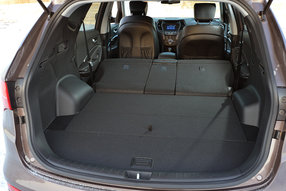
With a change in generations, the luggage compartment Santa Fe increased to good 585 liters. Under the floor, roomy niches that contribute to maintaining order. With the help of comfortable rear seat handles, you can fold it directly from the trunk, while receiving an almost even cargo platform. But, unfortunately, he lost his branded handle of opening the luggage door of Hyundai.
Modernized, softer, the suspension practically does not notice the small flaws of the asphalt, even twisting the reactions to a deeply drowned sewer hatch or a hole that suddenly turned under the wheel. But she refers to the lying policeman and rolled snow comb with obvious discontent, notifying the driver and passengers with unpleasant blows.
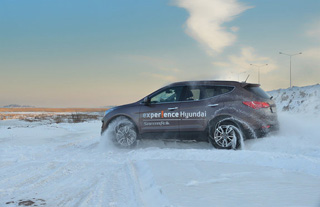
Search for progress in terms of technology in the new Santa Fe is not worth it. As before, it provides for two engines of a 2.4-liter gasoline atmospheric, with a capacity of 175 hp. And the 197-blue turbodiesel with a volume of 2.2 liters (although more powerful motors would approach its external data). Under the hood of the test Hyundai was the first, and the company was a 6-speed machine. If you go smoothly, without complaints about sports and drive, then the motor is enough for the crossover.
It accelerates sedately and, smoothly sorting through the gear and not annoying with noise, confidently rushes with cruising speed over the freeway. Such march-cuts for hundreds of kilometers is his element. But having appeared in front of the ring slow machine and, having dropped speed up to 80 km/h, Santa Fe can no longer quickly restore it. The engine is carefully buzzing, but the machine reflects and does not hurry with the transition to lower gears, and the tagging of it does not give the desired result with manual switching.
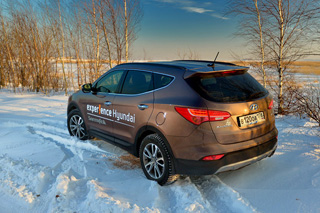
I discovered another small unpleasant feature of the box, having already gone to the snow path in an attempt to experience the newcomer's off -road abilities. Getting up on a small slope and pressing the electronic handbrake button, I released the brake pedal, but the car still moved forward by a centimeter. After that, the machine gun selector jammed, and it had to be translated from the parking through force. And this, unfortunately, was repeated quite often.
The construction of the four -wheel drive has not fundamentally changed by connecting the rear wheels by the head of a multi -disc couash, which, if desired, can be forcibly blocked by the button to the left of the steering wheel. What I did as soon as I went to the snow virgin land. According to a light crumbling snow and even on a beaten -out Hyundai rut, with its 185 millimeters of the road clearance, I boldly advanced, but I no longer dared to climb a low -located front bumper for a brave slope. It is he who, decorating the car in the world, on the off -road becomes that weak link that greatly limits the capabilities of the machine.
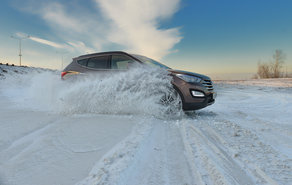
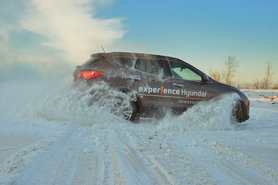
Well, Korean manufacturers have long realized that it is not necessary to perfectly verify the balance between the settings of the chassis, control and comfort, and off -road qualities can simply be indicated with a line of 4x4 in the performance characteristics. The layman needs just a beautiful and computer car, preferably with the raid of pathos and a lot of electrified options, everything else is secondary.
That is why the new Hyundai Santa Fe in terms of technological progress did not go away from its predecessor, but it has noticeably advanced in terms of the required qualities, it has become quieter, more comfortable and prettier. Moreover, the Koreans are sure that for the bright appearance and top -end package of the new Santa Fe, Russian buyers will be ready to pay the price ... Tuareg.

Hyundai Santa Fe price in the Russian market
The fact that over the past five years, the Hyundai lineup has significantly added in price, even noticeably naked eye. The price tags for all cars, whether it was a golf-class hatchback, a medium-sized sedan or crossover equal, and sometimes surpassed, the amounts in the price list of European and Japanese manufacturers. The new Santa Fe was no exception. With a change in generations, its initial cost increased immediately by two hundred thousand (!), To 1,299,000 rubles.
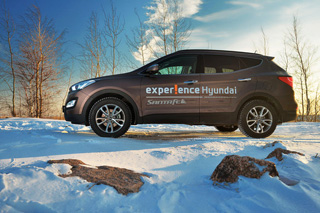
However, if you figure it out, this increase will not be so significant. After all, the basic version with a 2.4-liter gasoline engine (175 hp) and six-speed mechanics is now equipped with all-wheel drive and is available in more expensive Comfort, which already includes six airbags, heating the front seats, two-zone climate control, a two-zone climate control, a two-zone climate, Audiosystem and 17-inch alloy wheels. But for an automatic box with six steps, you will have to pay another 61,000 rubles.
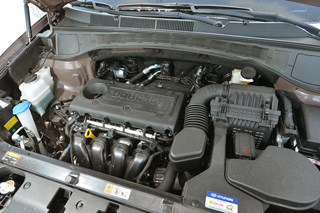
Prices for a car with a 2.2-liter diesel engine (197 hp) and automatically begin with 1,420,000 rubles. True, such a crossover will have a drive only on the front axle. A full -wheel drive option will cost 70,000 more.
Santa Fe in a seven -seater version of Family is available exclusively with a gasoline engine, but with xenon headlights, a rear view camera, a navigation system and a leather salon. The cost is 1,599,000 rubles.

The test car was in the similar configuration of Sport (1,595,000 rubles), in which, of course, he could not boast of the third series of seats, but had an electronic handbrake, a full set of electric regulations of the driver's seat and 18-inch wheels. By the way, his diesel version will be more expensive than 130,000 rubles.
Well, in the top-end performance of High-Tech with adaptive lighting, a carrier, a panoramic roof, a passenger seats, and a pressure sensors in the 19-inch Santa Fe tires are estimated at 1,710,000 rubles, a diesel copy of 1,840,000.
Competitors of the new Hyundai Santa Fe
Choosing a medium-sized crossover today is no easier than a compact sedan or a golf-class hatchback. There are a lot of offers in the market. Therefore, we single out from all this set only those that have the most similar to the test Santa Fe equipment. Because, if you compare in price, then the Korean’s competitors can be Pilot, Highlander and Murano.
Chevrolet Captiva with a 167-horsepower gasoline engine and automatic in the LT+version in power, which, however, will not have rear-view cameras, xenon headlights, navigation systems and heated rear seats, is estimated at 1,240,000 rubles.
Chevrolet Captiva
Mitsubishi Outlander in the Ultimate top configuration with a variator and a 167-horsepower engine will also be cheaper than a newly-made Korean (1,419,000 rubles). The crossover will be deprived of the adjustment and heating of the rear seats, but he can boast of the trunk door and a 215 mm road clearance of the doorway.
Mitsubishi Outlander
The most expensive Nissan X-Trail with a 169-horsepower four and a variator, performed by Platinum Edition, is not inferior to the Korean crossover and even has a panoramic roof, circular views and Bose audio system. And costs 1,513,500 rubles.
Nissan X-Trail
The Japanese Subaru Forester crossover with a 172-horsepower opposition engine and variator in the TV version can be bought for 1,469,500 rubles (with discounts even cheaper than 125 thousand). However, he will not have a navigation system and warm rear seats.
Subaru Forester
The technical double of Kia Sorento with the same 2.4-liter 175-horsepower engine and a 6-speed automatic machine, in the Prestige configuration costs 1,559,900 rubles. The rear seat of Sorento will not have a longitudinal adjustment, but the car will receive a car park, the front seats of ventilation, and the steering wheel heating.
Source: Wheel magazine [January 2013]

